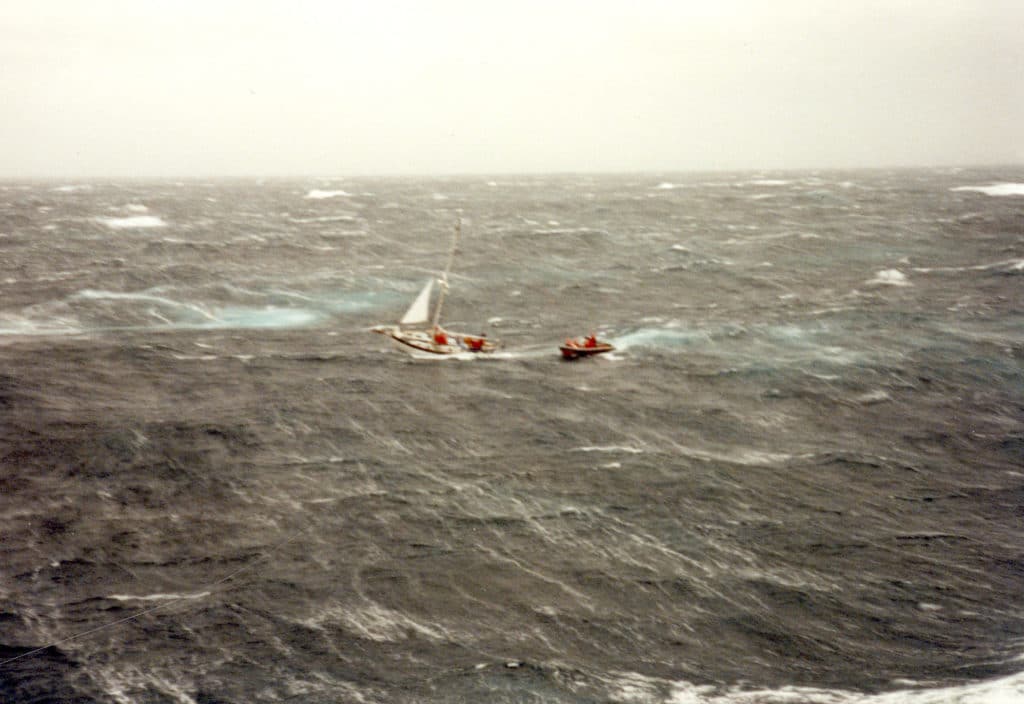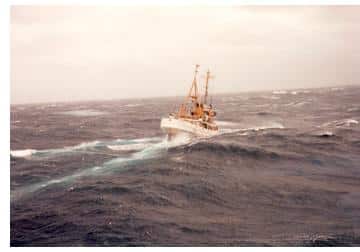
Most of those who earn their living on the water are familiar with the old adage “mackerel scales and mares’ tails cause tall ships to fly low sails.” Working far from shore, they know to keep a weather eye to cloud formations that portend incoming storms and a test of their seamanship.
Recreational boaters can avoid boating in bad weather for the most part by checking the marine forecast before heading out and postponing their cruise until the weather improves. But once on the water sudden severe thunderstorms are still a hazard and can materialize out of nowhere. That’s when seamanship—the ability to pilot a vessel effectively under adverse conditions—comes into play. It is a skill acquired over time and involves a broad understanding of your vessel and how it handles in different situations and with varying loads. It also requires knowledge of wind, water and geography, information that can be gained both in the classroom and in on-the-water training. You and your boat need to be prepared at all times. Anchors and rodes should be kept in a state of readiness, along with life jackets and all other safety equipment.
No two storm situations are alike. Many small boats are not designed or constructed to take a heavy pounding and the result can be structural damage that can cause the boat to break apart. In strong breaking waves, flooding and capsizing may occur. In beam seas (waves perpendicular to the side of the boat), excessive roll can cause your load to shift, creating a dangerous list. In following seas (waves coming from behind the boat), your vessel may lose stability on a wave crest; plus, if your speed is excessive, broaching may occur – a situation where the vessel runs down the crest of a wave, gathering speed, and buries its bow into the backside of the next wave. This frequently causes the boat operator to lose control and the vessel to veer sharply off course. In quartering seas, beam and following seas combine to create one of the most serious conditions a boater may encounter.

In a sudden storm, your most immediate problems are limited visibility, high winds and – depending on your location – rapidly building seas. Try to remain calm. Have everyone dress as warmly as possible, put on their life jackets and, if possible, go below. Close all hatches, doors, watertight compartments and windows to reduce the amount of water taken on board. In an open boat, passengers should sit low in the bottom of the boat along the center line.
Although you need to get your boat to the dock as quickly as possible, once waves reach a certain height, safety dictates that you match the speed of the vessel to the speed of the waves. That means slowing down a lot. The more you reduce speed, the less strain will be put on the hull and superstructure and less risk that portholes and windows will pop out or break. Keep your vessel at a 45-degree angle to the wind and make slow but steady progress to the nearest port.
Stay away from rocky shorelines. If you’re far from port but have shelter available, such as islands and peninsulas, sheltering may be a good idea depending on the depth of the water and the condition of the shoreline. Just bear in mind that in most thunderstorms the wind direction will probably change. In a thunderstorm, winds generally blow outward from the area of heaviest rain. As the storm approaches, winds come straight at you. As it passes overhead, the winds ease off, then reverse direction. Understanding this pattern can give you a reasonable idea of how long you’ll be fighting the storm. In smaller boats, putting up on a sandy beach may be a good idea. If you perceive the situation as life threatening, it’s better to sacrifice the boat to save yourself and your family or friends.
Roughing It Out
Being out on a boat in bad weather, even within sight of the shore, puts you farther from help than you might think. No one can tell you precisely what to do because every situation is different. Play it safe. When a storm threatens, head for the nearest dock or sheltered waters immediately. Do not attempt to return to your original marina if there’s a safe haven closer by. If you can’t make it to shore, follow the guidelines below:
- If you have passengers aboard, get everyone into their life jackets and foul weather gear now.
- Secure all hatches and close all doors, ports and windows to keep water out.
- Secure gear above and below decks; stow small items and lash down bigger ones. The weight of gear and passengers is especially important in smaller craft. Keep your load low and balanced.
- Ready any emergency equipment that you have on board: bailers, hand pumps, first aid kit, signaling devices, etc.
- Pump bilges dry and repeat as necessary to eliminate any sloshing of water as the boat rolls, which can effect stability.
- Get a fix on your position and plot it on your chart. Note your heading and speed, and the time. Chart your course to the nearest shore or dock.
- Monitor Channel 16 on your marine VHF radio for Coast Guard updates on the weather. Also, listen for distress calls from other boaters. You may be the closest one that can lend assistance.
- Ready your sea anchor or drogue in case it should be needed, but do not anchor the boat unless you’re in a narrow body of water, you’ve lost visibility completely and are in danger of washing ashore. Under those conditions, anchor your boat from the bow to keep the boat headed into the waves.
- Turn on navigation lights.
- Reduce speed and head your boat into the wind at a 45-degree angle to reduce stress and maintain better control.
- If there is lightning, keep everyone away from electrical and ungrounded components, and as low in the boat as possible.
- Switch to a full fuel tank, if possible.
- Maintain a lookout for floating debris, obstacles and other boats.
- If your vessel has a flybridge, operate your vessel from below if that is an option.
- If you’ve lost visibility temporarily, maintain a slow headway until visibility improves.
- On larger craft, rig jack lines and/or lifelines and require anyone who must go on deck to wear a safety harness, if available.
- If the incoming storm is extremely severe, review your procedures for abandoning ship, including sending a Mayday to Coast Guard Search and Rescue.
- If you have a life raft, have it ready to be deployed and stocked with emergency food and water. Be sure you have a sharp knife to cut it free from the boat.
- If you are in fear losing the boat, get everyone on deck and send a Mayday on your marine VHF-FM radio.
That Other Weather Hazard: Fog
It is rare to encounter heavy seas with fog, but it can happen. When it does, the rolling of the vessel combined with reduced visibility can cause the operator to become disoriented. Fog brings the greatest risk of collision with an obstacle or another boat, so do the following before your visibility becomes seriously reduced:
- Fix your position on a chart or mark it on an electronic plotter
- Reduce your speed to the point where you can stop your vessel in half the visible distance
- Turn on your navigation lights.
- Instruct any passengers to help you keep watch – by sight and hearing – preferably in the bow.
- Begin sounding one long blast on your horn (4–6 seconds) every two minutes while under way and two long blasts every two minutes when stopped.
The U.S. Coast Guard is asking all boat owners and operators to help reduce fatalities, injuries, property damage, and associated healthcare costs related to recreational boating accidents by taking personal responsibility for their own safety and the safety of their passengers. Essential steps include: wearing a life jacket at all times and requiring passengers to do the same; never boating under the influence (BUI); successfully completing a boating safety course; and getting a Vessel Safety Check (VSC) annually from local U.S. Coast Guard Auxiliary, United States Power Squadrons(r), or your state boating agency’s Vessel Examiners. The U.S. Coast Guard reminds all boaters to “Boat Responsibly!” For more tips on boating safety, visit www.uscgboating.org.








